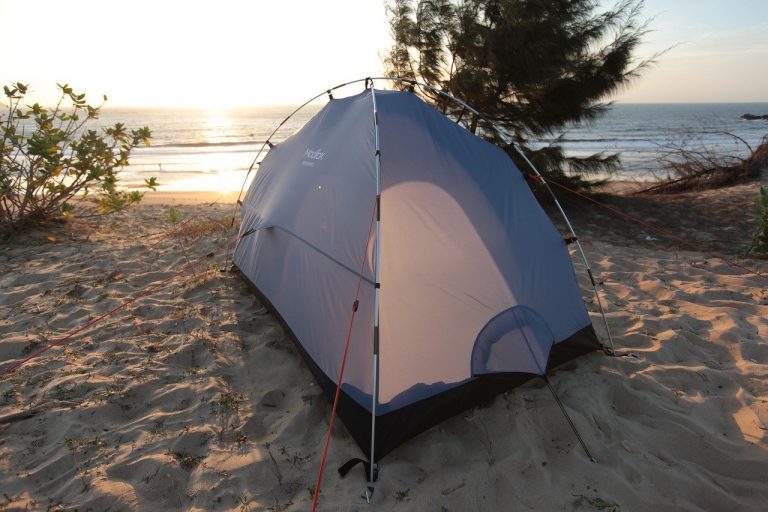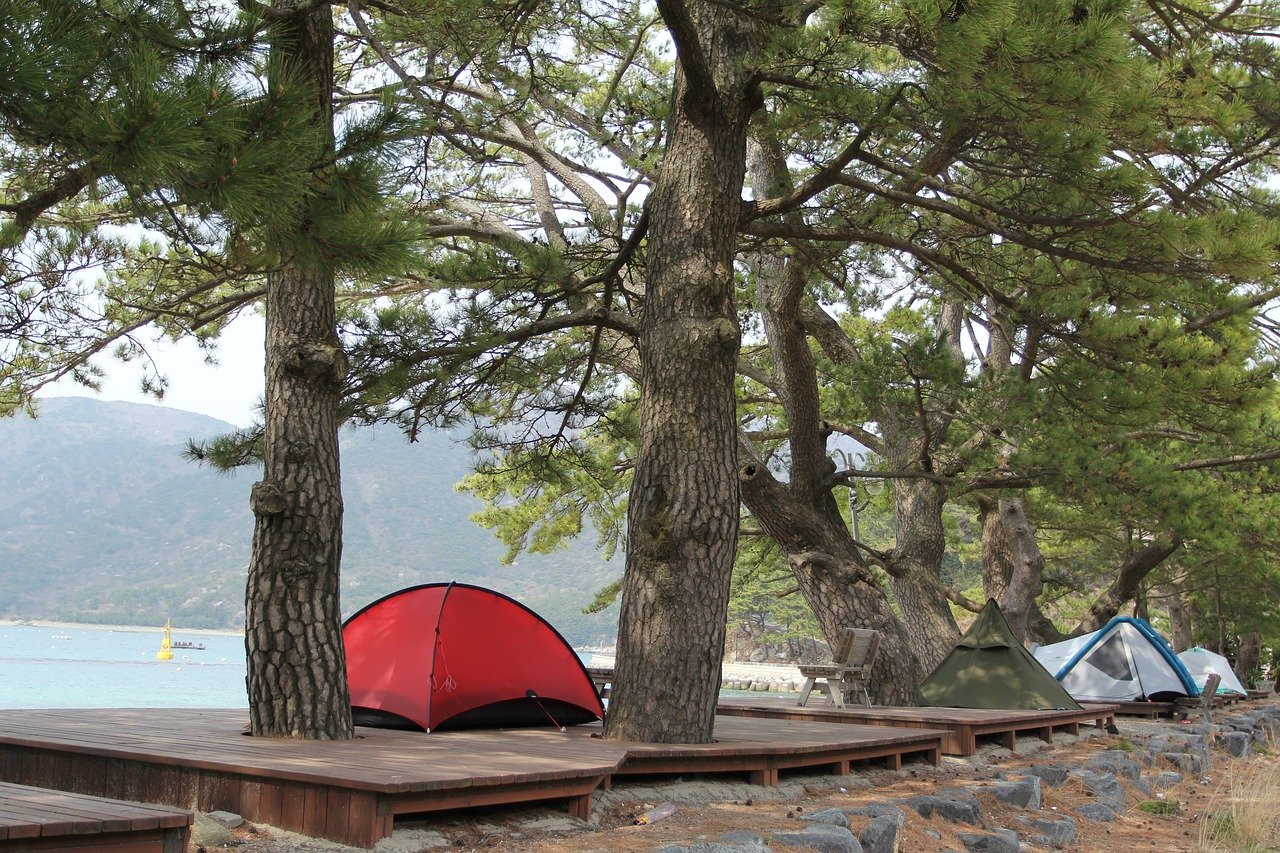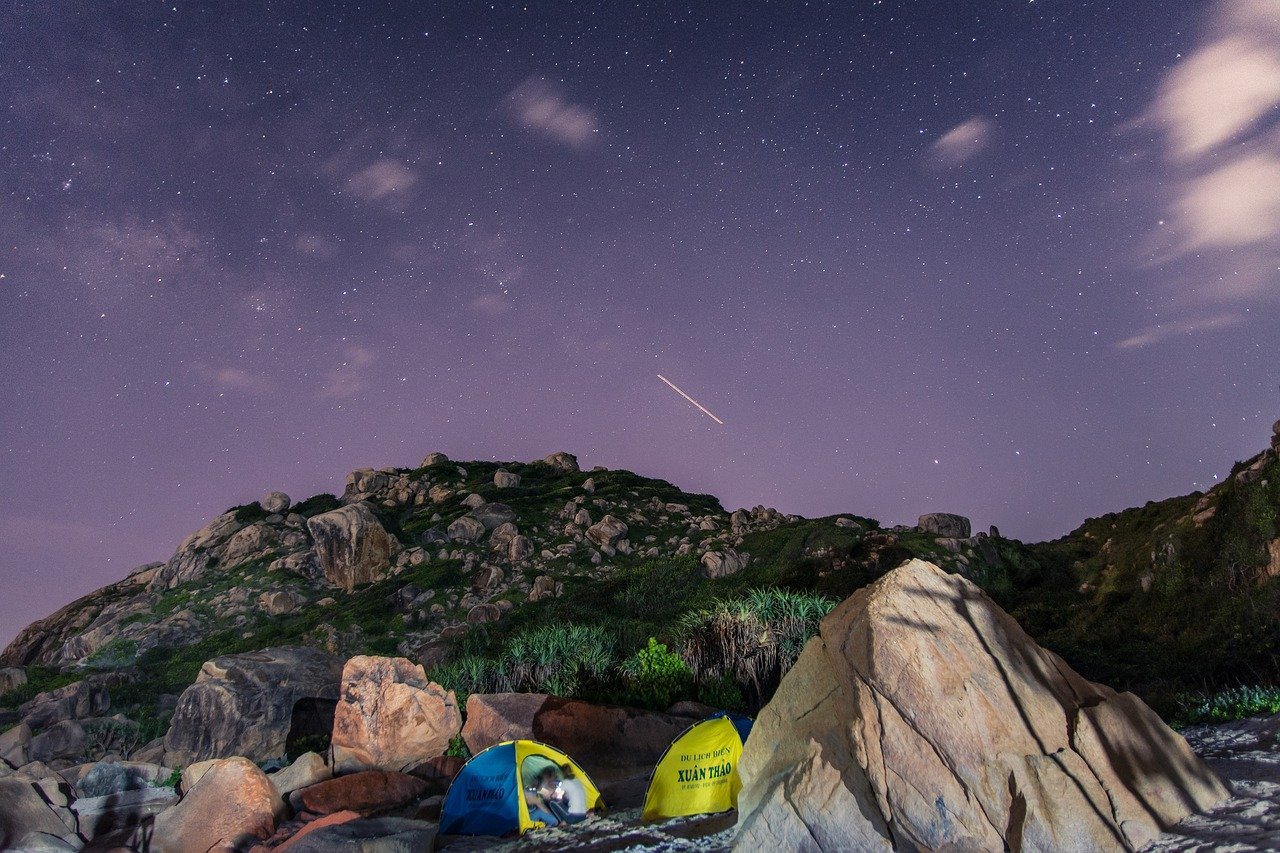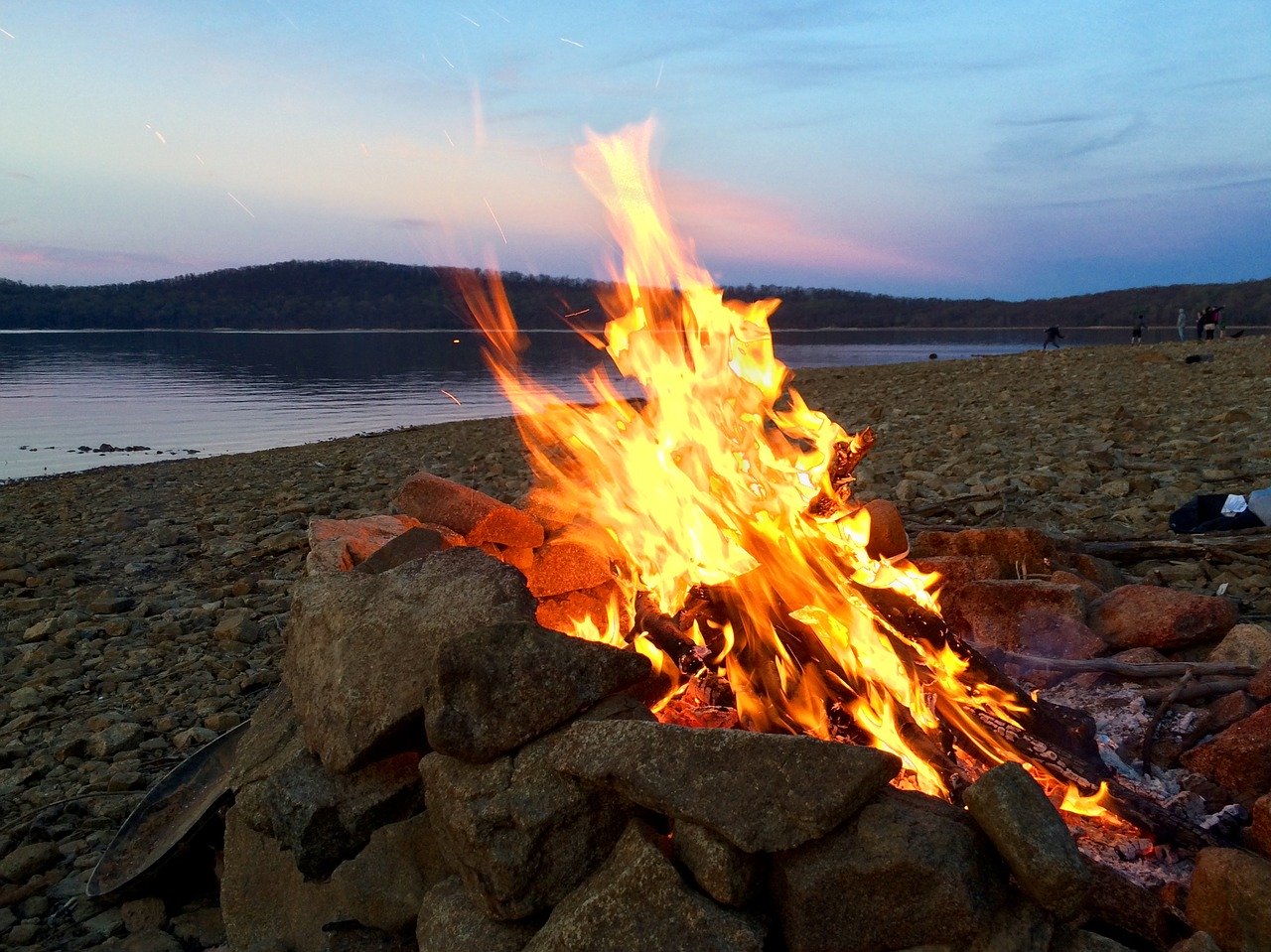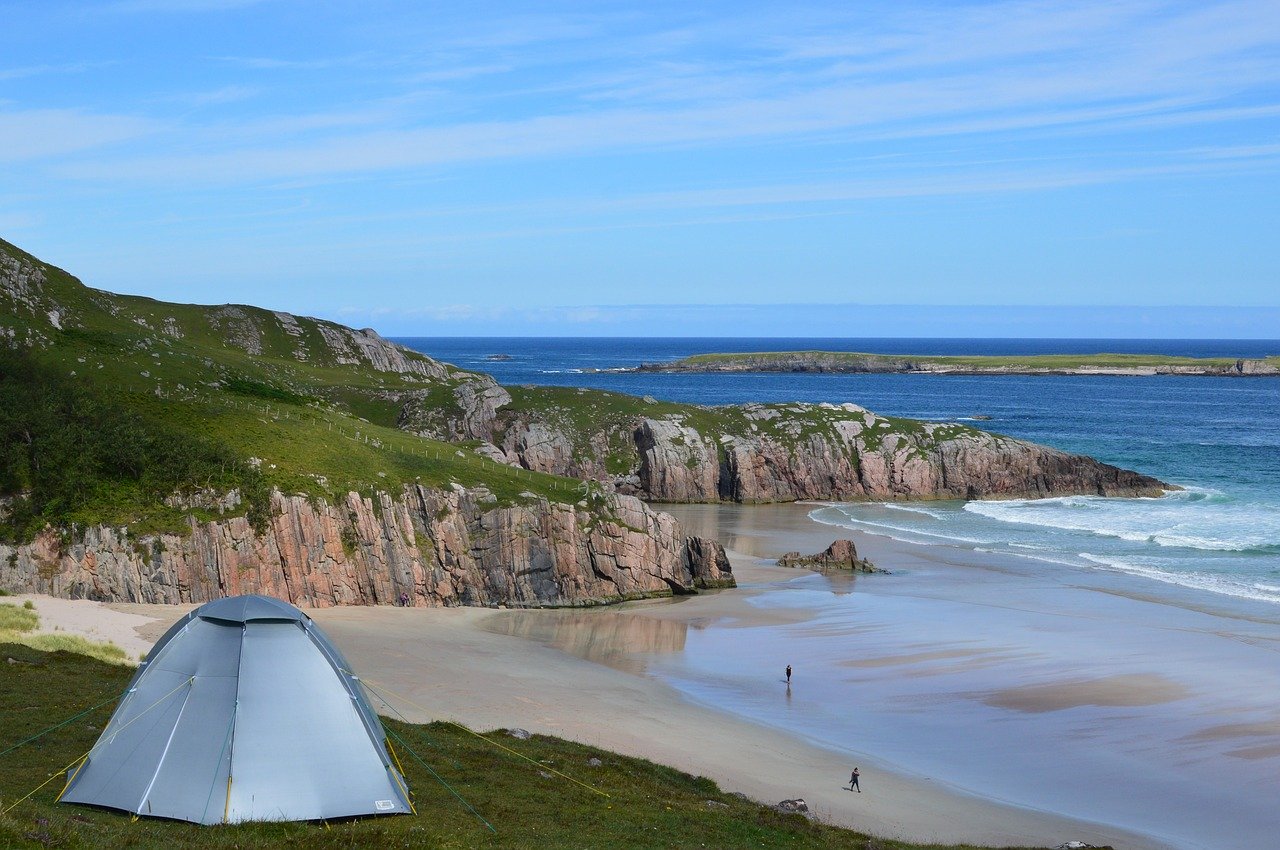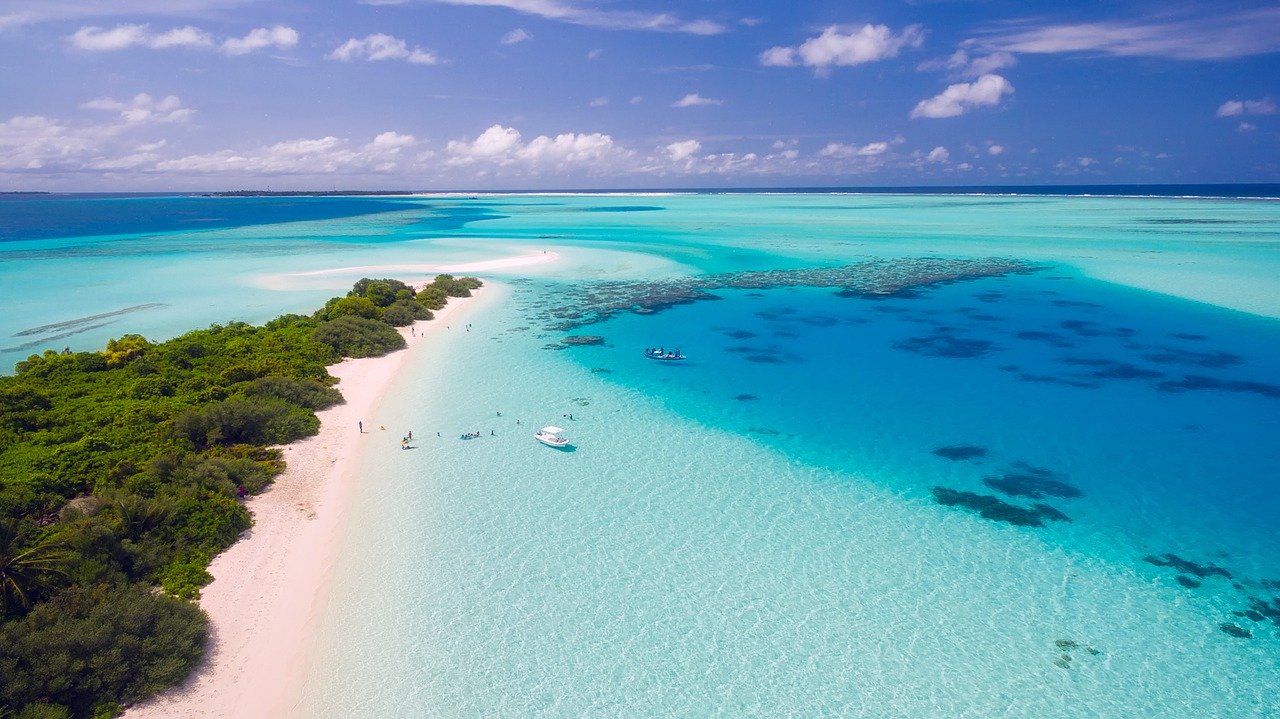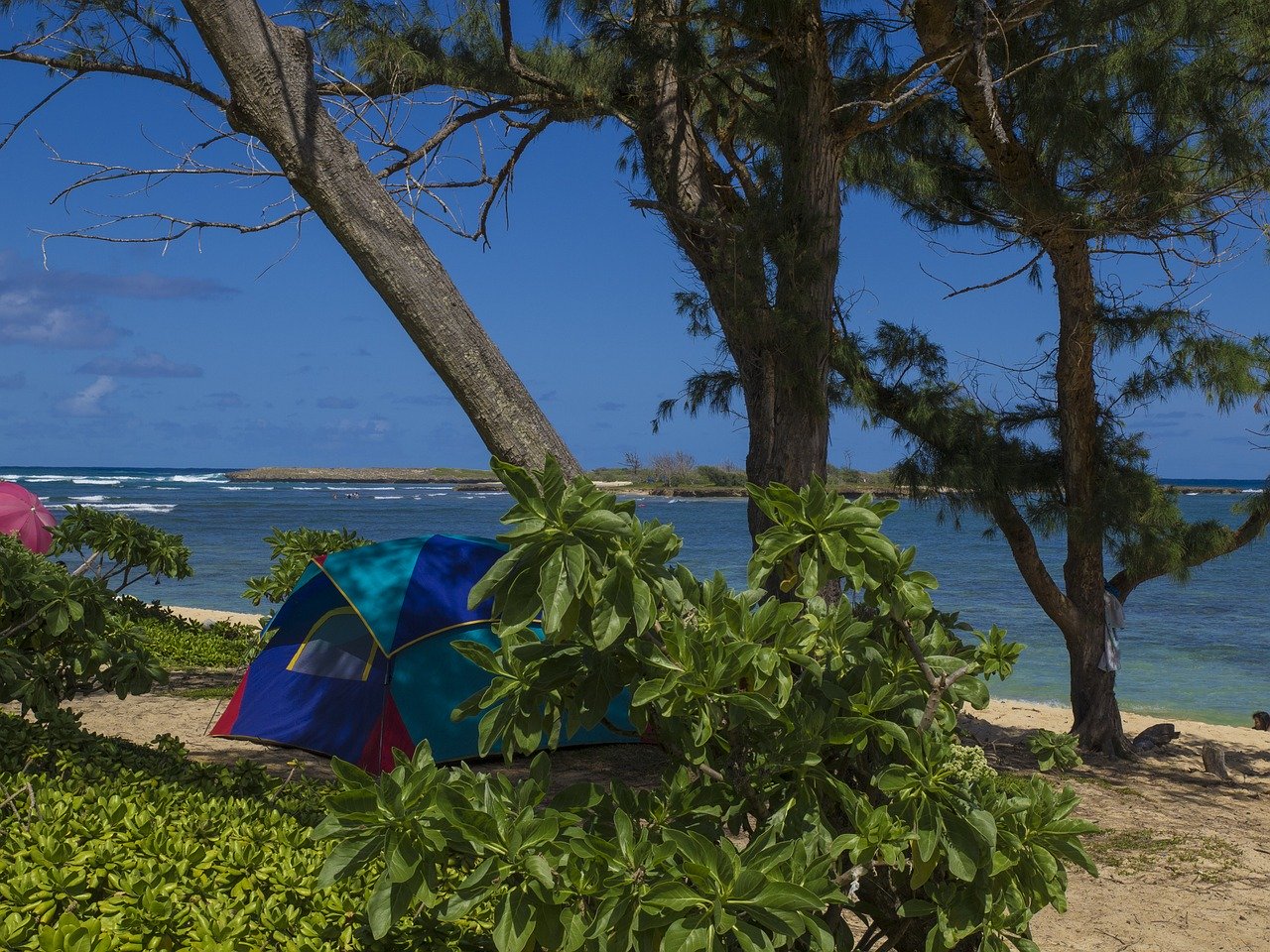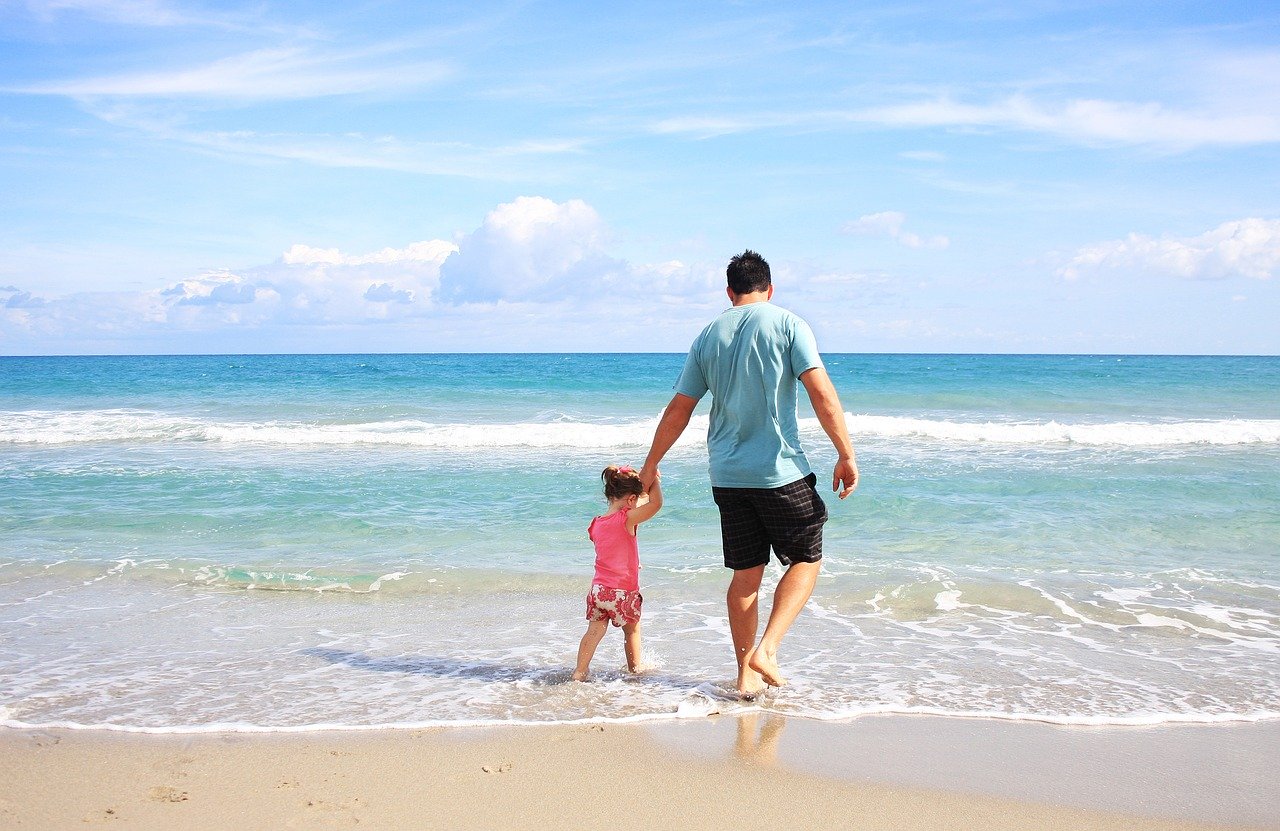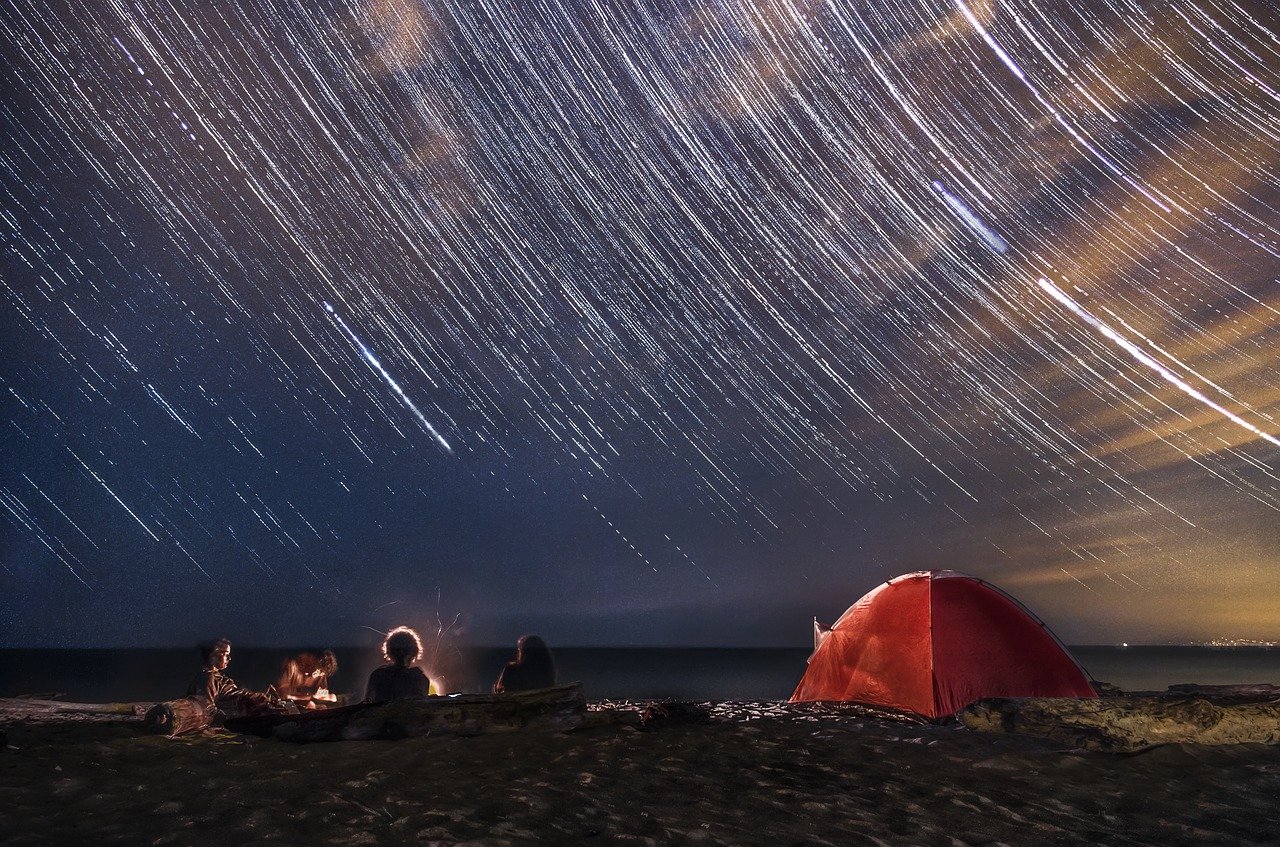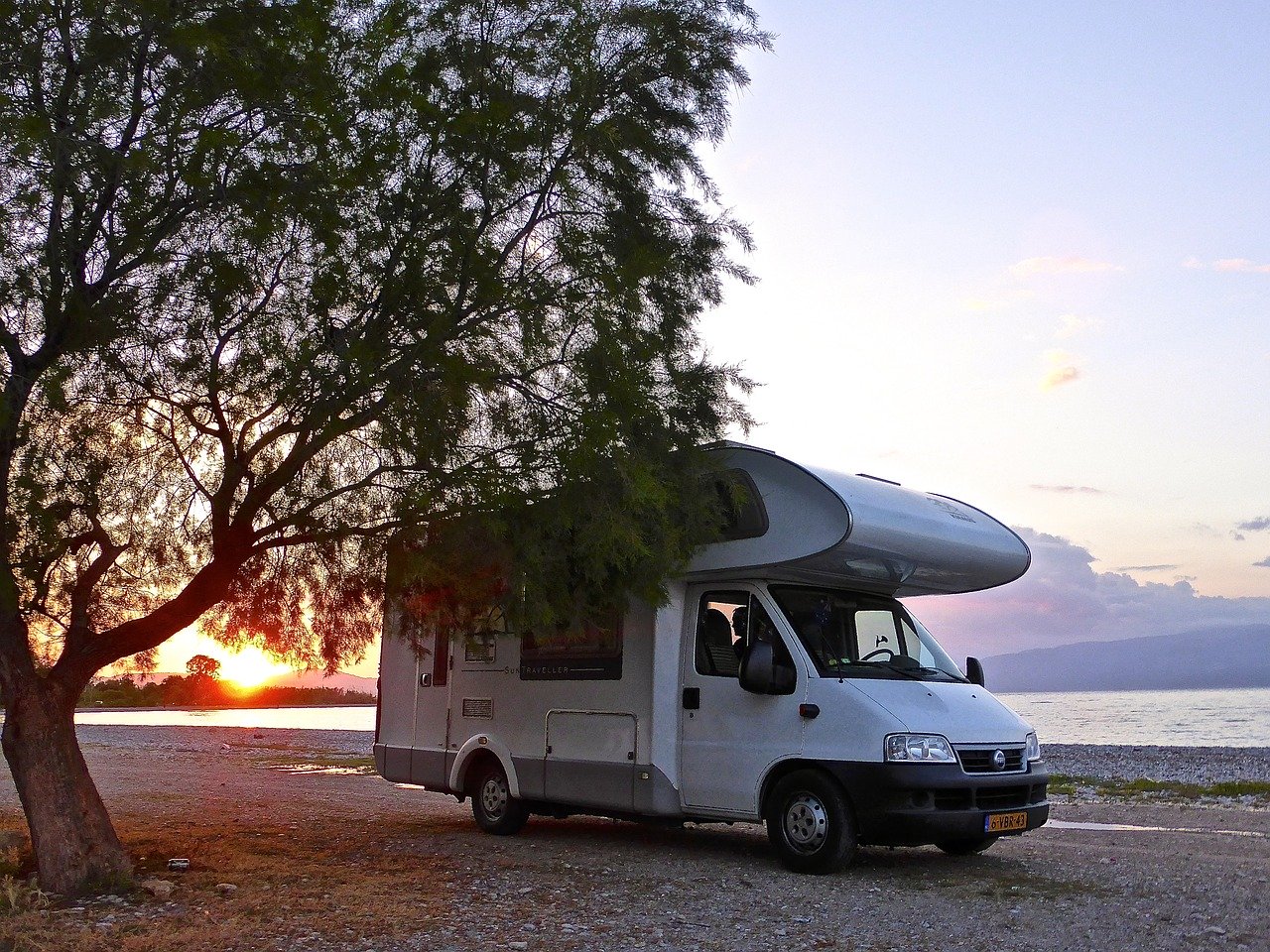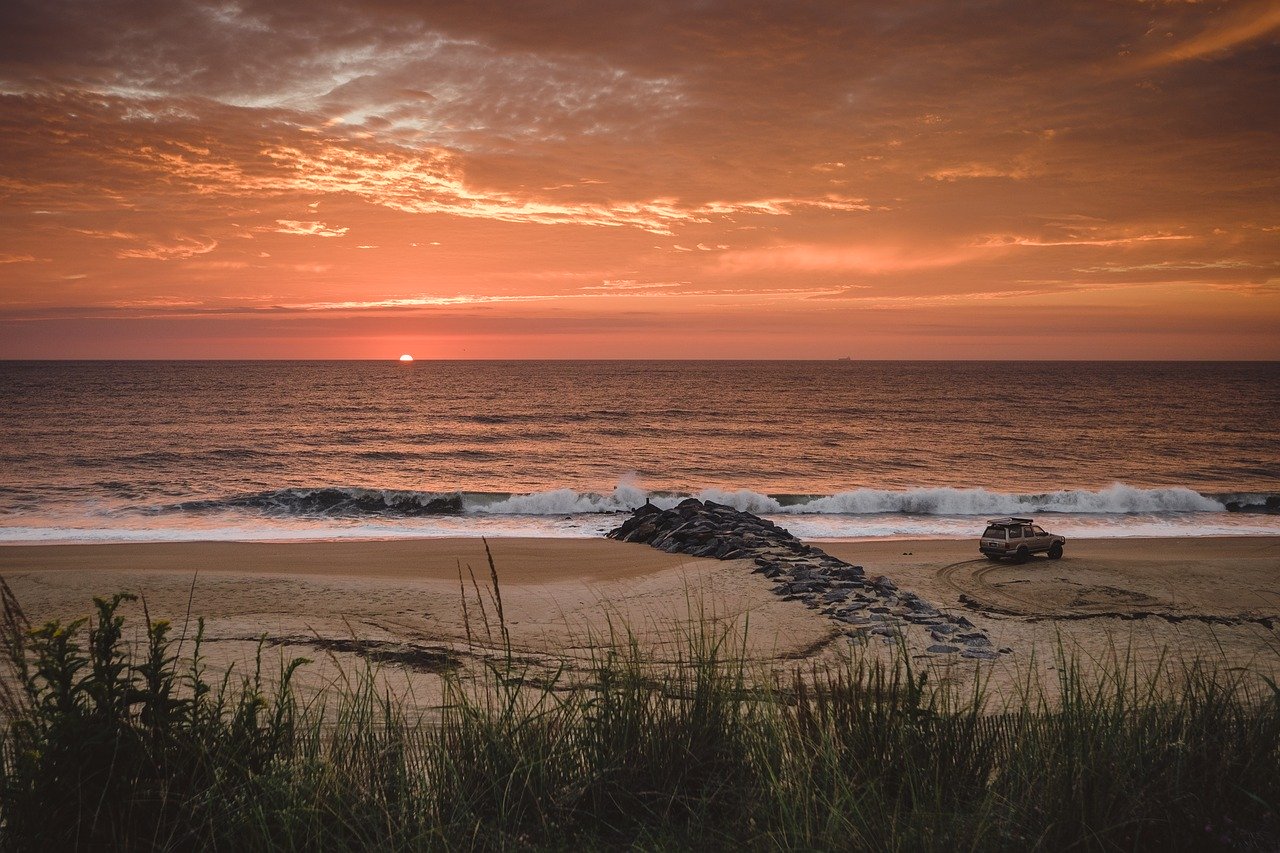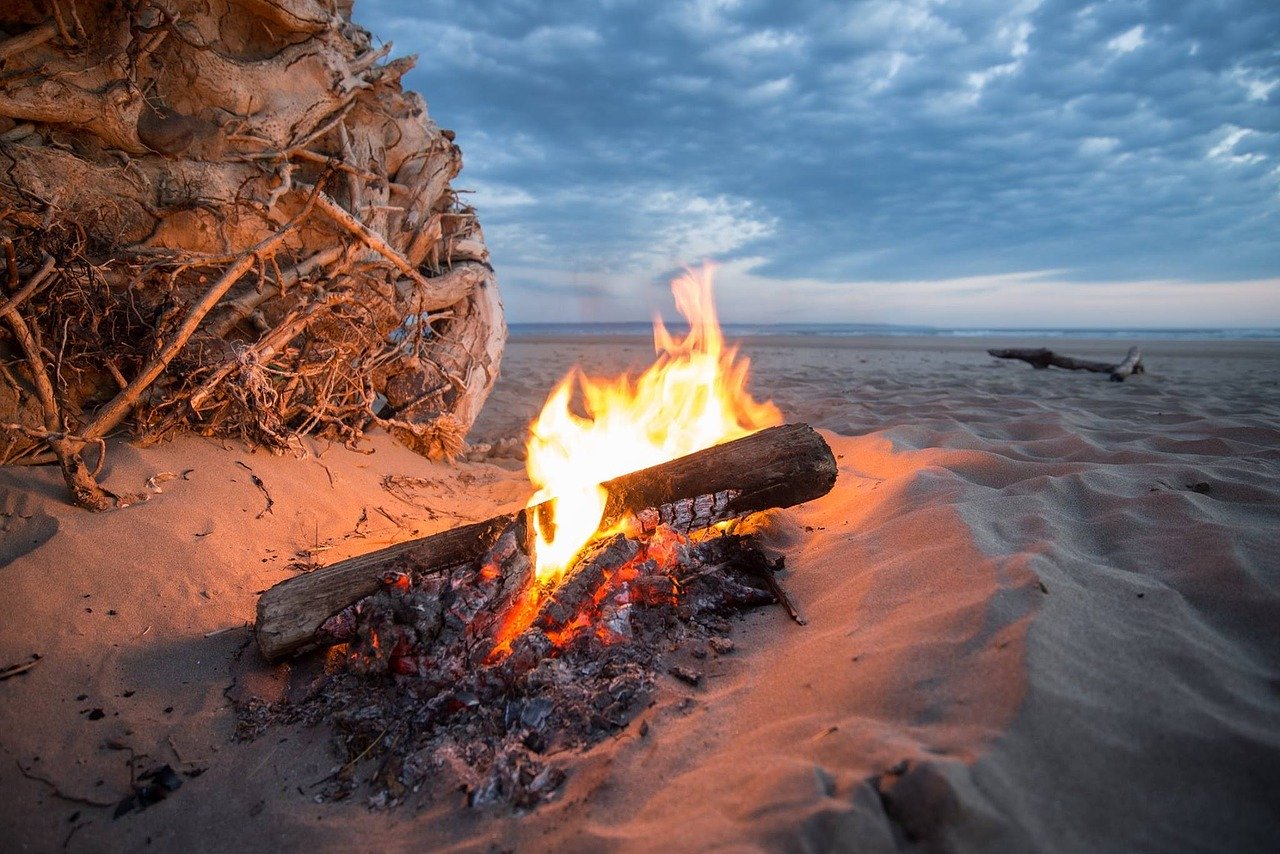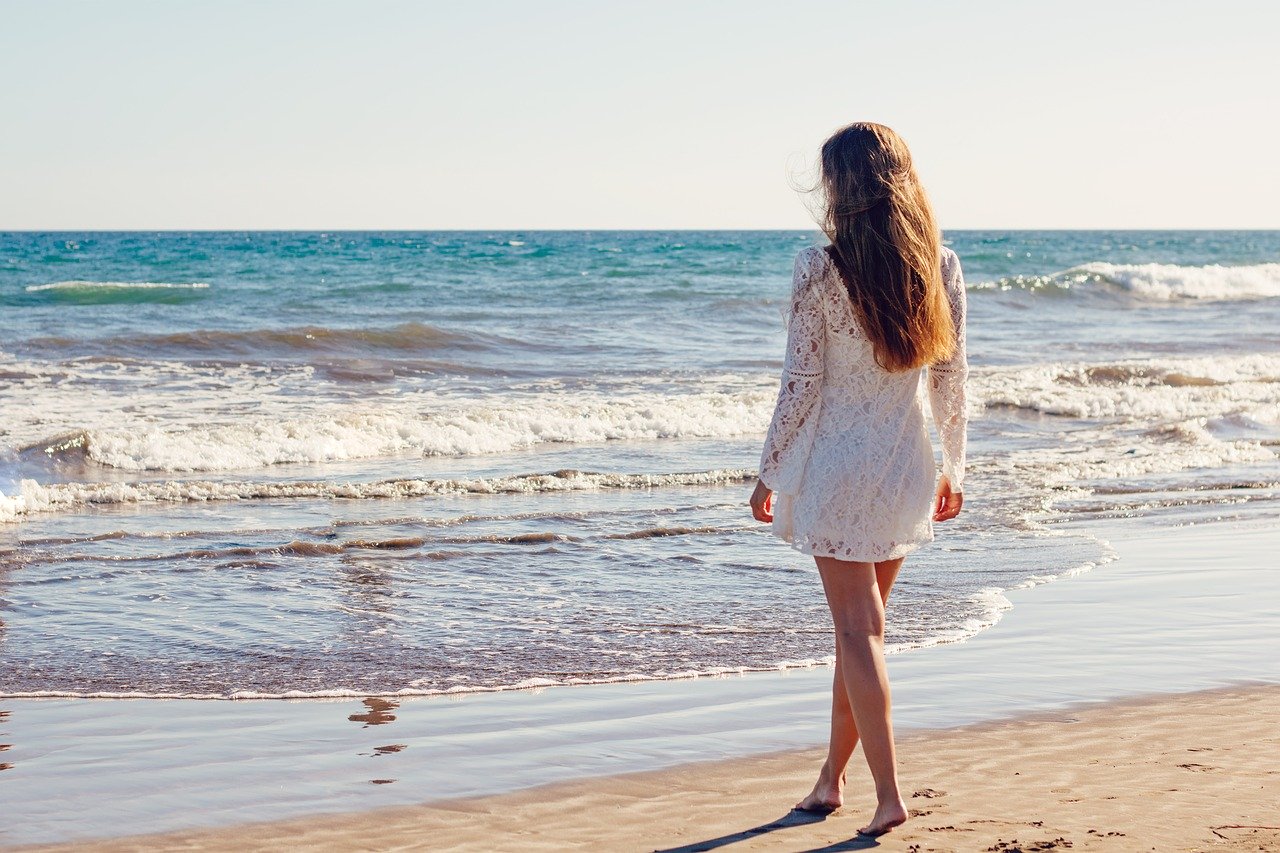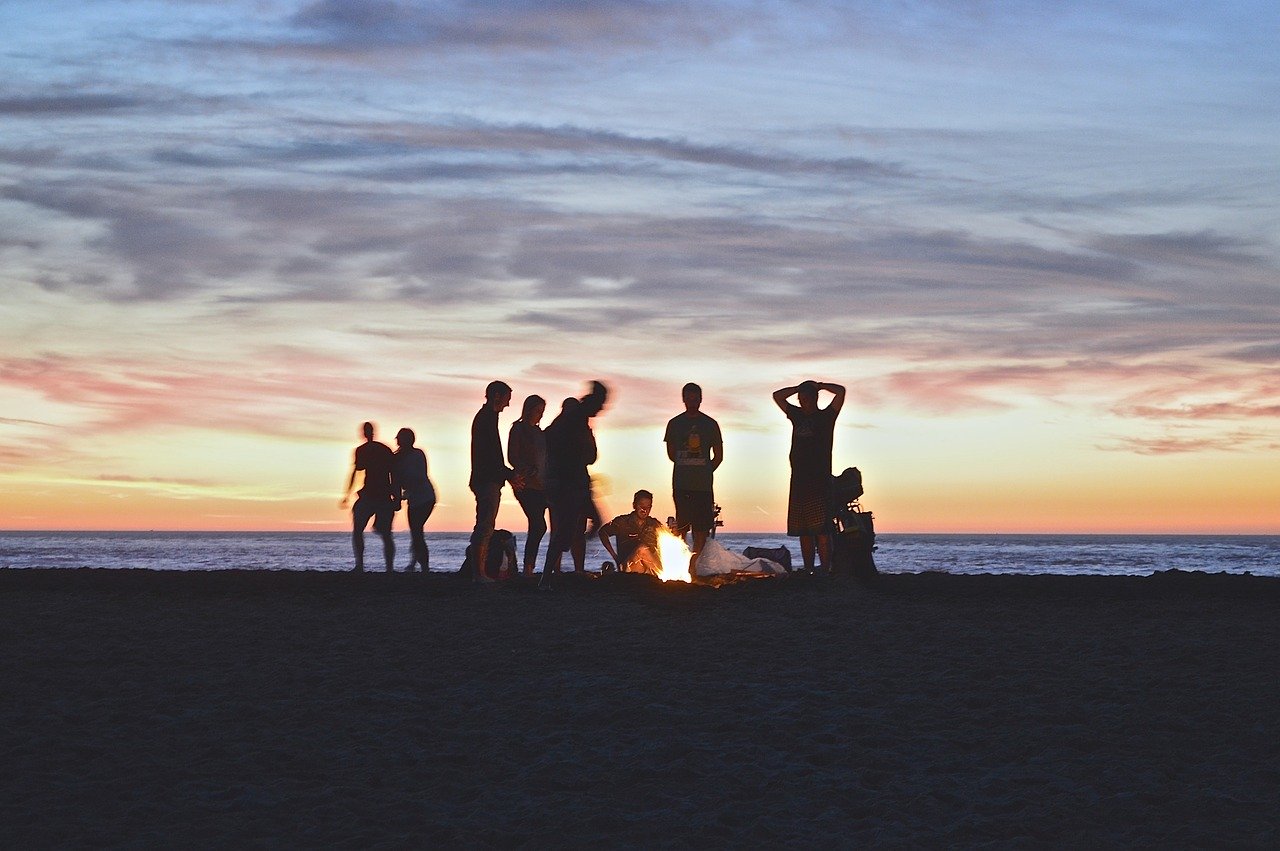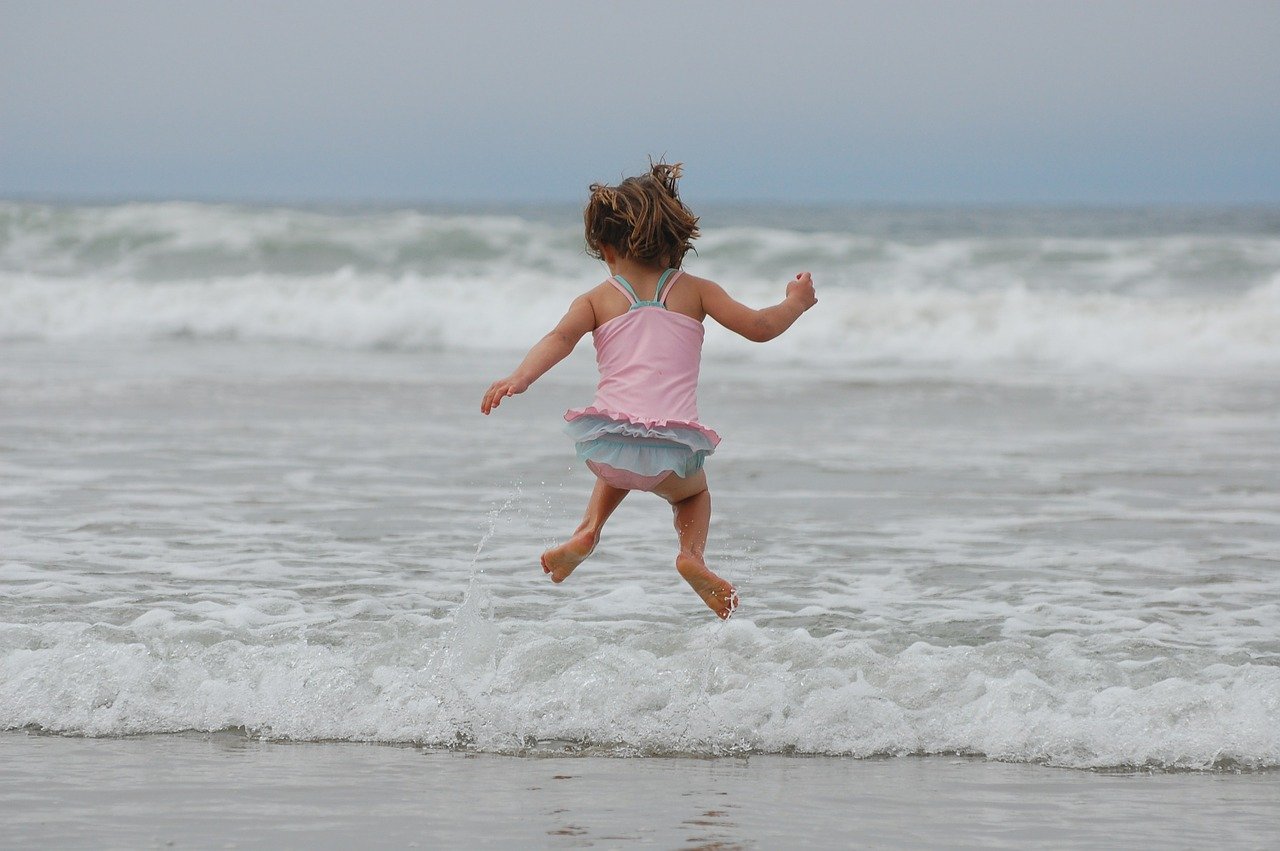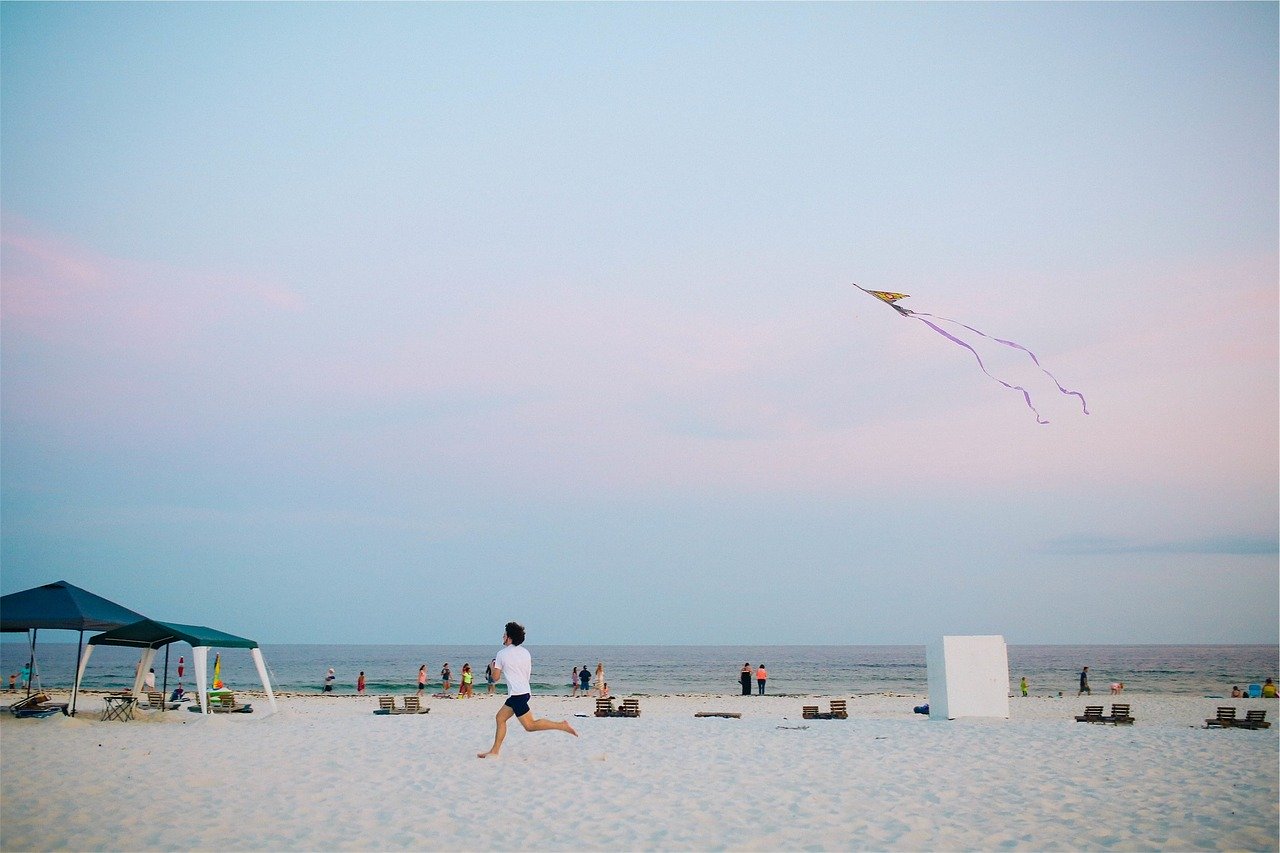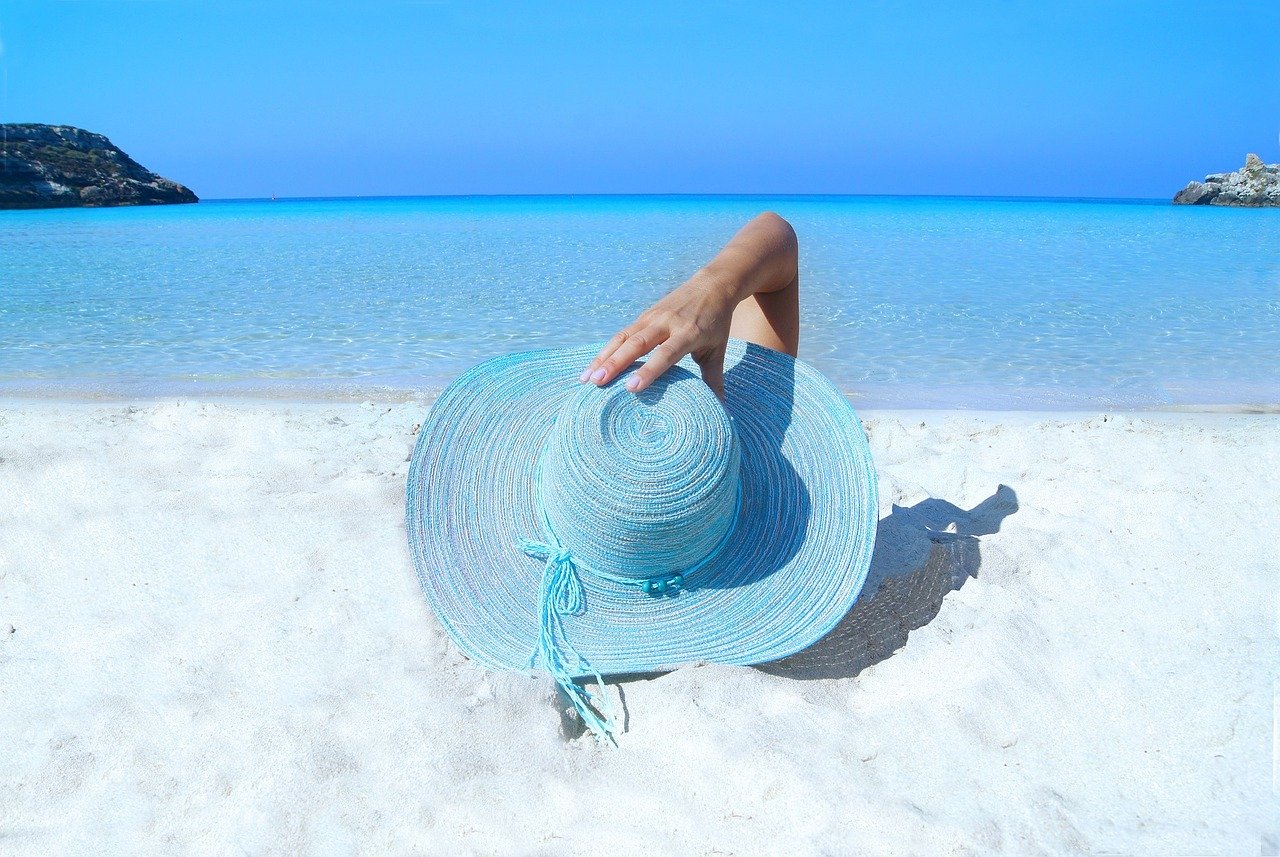If you need a weekend getaway, or to simply find some peace of mind from the daily grind, going beach camping might be the best choice.
In fact, it’s one of our favorite places for camping. Sometimes will spend an entire summer on the coast going to different locations that will inspire you to do this every year.
What we will do now is present some of the tricks we have learned on how to really enjoy beach camping today.
Reasons to Try Beach Camping
- The Best Views: An excellent thing about camping on a beach, especially on the West Coast, are the amazing sunsets and the sunrises on the East Coast. If you are a night owl, you can enjoy drinking coffee watching the sunrise, or watch the sunset over a campfire.
- Save Your Money: It could cost you as much as $50 a day for a camping spot on some beaches which are private. This is a lot cheaper than getting a hotel. You won’t have room service, but you will certainly save some money.
- Best Sounds in the World: If crashing waves and crickets are appealing to you, you can fall asleep listening to them. Listening to nature as you fall asleep is a great bonus.
- Excellent Getaway: If concrete buildings are not appealing to you, camping can be very beneficial and relaxing as well. It’s a change of scenery, especially for those that are from the city.
- De-Stress: A natural way to reduce your stress is being in the midst of nature. By surrounding yourself with trees, water, and sand, you can disperse all of that negativity that you have accumulated.
- Great Places to Eat: There are some that like camping food more than any other kind. You can roast corn, hotdogs, and build your own fire to cook it. Some people are born fishermen and will be able to catch their own dinner! There will be a sense of accomplishment in building a fire, and cooking your own food when you are camping. Did we mention you could cook s’mores? This is really a good reason to consider camping. Yum!!
- Helps Your Skin: Being on the beach could also be very beneficial for your skin. First of all, send can exfoliate your skin into something very smooth. You can also get the rough skin off of your feet by simply taking off your shoes.
- Exploration: Camping on a beach will allow you to explore many different areas, allowing you to feel like a kid. There will likely be natural habitats, cliffs, waterfalls, and a multitude of plants and animals. Wouldn’t it be great if you can also find a treasure?
- Tied Pools: Although it depends on where you will be camping, tied pools might be there. Early in the morning is when you will see the lowest tide. During this time, you can find crabs, sand dollars, starfish, and a wide variety of plants.
- Heal Yourself Physically: If you opt for not using an air mattress, it is said that you could actually realign your spine. Additionally, when you don’t have electronics with you, your circadian rhythm can come back and provide you with better sleeping habits that you will likely retain for many months to come.
How to Choose the Perfect Campsite
Similar to camping in the woods, beach camping does have a few differences. There will not be a lot of trees and you may find it difficult to get any privacy at all. However, it’s still going to provide you with a good time.
To make the most out of your trip to the beach on your camping trip, choosing the best campsite should be your priority as you prepare for having an outstanding trip camping on a beach.
Beach Campsites
Designed for weekenders and casual campers, finding a designated camping area will actually allow you to be near the ocean. You may have access to drinking water and washrooms if they are designed to be convenient, plus you can picture a tent and feel absolutely safe. You can also socialize with multiple people just like you if that is what you are trying to accomplish.
Wild Beach Camping
Conversely, some of these campsites will be expensive as well as restrictive. If you do want to experience something more remote, you can easily find a hidden beach if you want to, yet keep in mind that you may pay much more than you would at a regular campsite.
If you do have a perfect spot picked out, simply go there. If you don’t, ask people that may have knowledge about local areas, individuals that may or may not live in your community, such as those you will find online. You may find forums and local message boards to do your research and find good places for camping.
Once you have found this place, go to Google maps and see what is there. Determine how you will get there, if there is drinking water, and be sure to bring a boat, camping gear, and extra drinking water if there is not going to be any. Confirm with the local regulations if you are going to be staying there overnight as you may need a permit to be legally there.
Fees
Many places that are legal to camp at don’t charge you anything, yet they do require that you schedule a reservation. It all depends on where you are going. You can see online if there are fees associated with this locale. In most cases, paying more than $30 a night is unlikely unless you are on a private beach that is more exclusive.
Laws
Always abide by the laws that pertain to the particular beach that you are on. You may find that one beach has different rules than another that is adjacent to the one you are at. They may have hours of operation, and may not allow you to do things overnight. You need to do research to determine what laws you need to follow so that you will not break any and inadvertently get charged fees along the way.
Restrictions
Restrictions could possibly happen depending upon where you will be camping. In some cases, people need to be above the age of 18 to be there. They may also tell you what you can and cannot bring with you. For example, you may not be able to bring an RV, or a gas stove, or they may tell you that swimming after sundown is not possible.
Requirements and the Terrain
What you may discover is that some of the best beach camping destinations are not on the main road, yet are located far off the primary road that goes into this area. If this happens to you, be sure to rent or bring the proper vehicle so that you can get yourself, and your equipment, to the campsite to have a good time.
Finding the Best Spot for Camping
Avoid Setting up Near the Shoreline
Once you choose the park and you arrive at the beach, it’s time to set up your tent. You want to find the best spot to set up for your beach camping trip. The last thing you want to happen is to wake up soaking wet from getting hit by a wave. Therefore, you should always look for areas far enough away from the shore.
Ideally, you want to mark where high tide hits. From there, you should be looking to place your tent anywhere beyond that point. You can even ask park attendants where high tide reaches and they will be able to point to the area that you should avoid.
If you aren’t able to find the high tide, you can simply look for a spot that is a minimum of 100 feet away from the shoreline. This will give you plenty of room for error and you can sleep peacefully without having to worry about waking up soaking wet.
You can also gauge where you should be looking to set up your tent by following the other experienced campers’ footsteps. Look to see where they have set up their tents. This will give you a good idea of where you should be setting yours up. After all, if everyone is far away from the shore, you will want to spot your tent around the distance they have chosen.
Look for a Spot Where There Is Vegetation
Even if you have decided to set up your tent far away from the shoreline, you might find it getting damp if it’s placed directly on the sand. Whenever you are setting up on the sand, you will be much more exposed to the elements including the sun, wind, and rain.
Instead, you might want to opt for a spot where you see vegetation growing. This way, you will be able to take advantage of a spot where the soil is much more firm than the sand. Likewise, it can offer a lot better and more sturdy shelter than what you would get with a spot on the beach. Likewise, the vegetation can help to provide you with a much more shaded spot to set up the tent.
Looking for vegetation is certainly a good idea. That being said, you do want to avoid choosing a spot that has a lot of vegetation growth. A lot of taller vegetation is likely going to shelter pests and critters that you will want to avoid entirely.
Avoid Setting Up Near Damaged or Dying Trees
When you are looking to pick a spot, you should look for trees that are heavily damaged or dying. There will likely be a lot of trees in this state because they are getting too much water which is causing their roots to rot.
Obviously, you want to avoid setting up near these trees because they are going to be very dangerous to camp around. After all, you never know when the tree is going to collapse.
Find a Private Spot
If you are someone who would rather enjoy your own privacy while camping, you might want to find a place that is much more private. Unfortunately, it can be difficult to find a spot that is secluded while camping on the beach.
However, if you walk around enough, you should be able to find an optimal spot that you can set up your tent at that should offer you decent privacy. If not, you can set up a privacy screen.
As mentioned, avoid setting up your tent near a damaged tree. That being said, a healthy tree is something that you can leverage as a means to generate more privacy. It can even help protect you from the harsh elements that you would otherwise face on the beach.
If you cannot find any trees in the area, you will be able to find a spot that is further away from the rest of the campers on the beach. Rather than setting up your tent right when you enter the beach, walk further down and you should be able to find an empty spot.
Look for Flat Land
While you don’t necessarily need a spot that is completely flat, you should be looking for an area that is relatively flat. That way, you will be able to set up the tent easier and it can be more comfortable.
Keep in mind, you want some sort of slope because it can keep your area from flooding. A slight slope is going to allow for better drainage than an area that is completely flat. Likewise, it can be more comfortable to sleep on a slight slope. You just want to be sure you are placing your sleeping bag on the upper portion of the slope.
Don’t Set It Up on a Sand Dune
You should always avoid setting your tent on a sand dune. This is prohibited on a lot of beaches because they are a natural environment for various species that live on the beach. Likewise, these areas are prone to erosion. Therefore, you should avoid them entirely. By setting your tent on a sand dune, you will be disrupting the species that live on it and you will likely contribute to more erosion.
It’s important to note that you are likely not going to have unlimited options when it comes to camping on the beach. You will need to find what areas have been designated (if any). With various parks, you will have campsites already designated and chosen.
If you are looking to avoid having to choose an area yourself, you can always find a beach park that gives people individual plots they can use. This will help you avoid having to deal with picking your own campsite at the beach. For these parks, you really only need to worry about your proximity to the restroom.
Locating the Restroom
In a campground that is primitive, you will want to first locate the areas that are designated public access restrooms. You then want to figure out how restroom activities are handled at the park.
For instance, you might be able to camp close to them. Whereas, if it’s not an option, you can camp away from it and include a privacy tent that has a camping toilet. You need to have a plan to head to the restroom when it’s dark out.
For the more developed campgrounds, you might want to choose a site that is close to the restroom. That being said, you might not want to be too close to be disturbed every time someone needs to go to the restroom.
Book Early
During busy times, you are going to find these beach campgrounds very populated. Because of this, you are going to need to contact the park and reserve your site if you want to find and reserve the best one.
You will typically find the more populated RV parks getting less visited during the latter parts of summer which can make it the ideal time to visit.
The Best U.S. Beaches for Camping that You Should Visit
From Washington state to California, there are many campgrounds that will give you access to the Pacific Ocean on the East Coast, in areas such as Massachusetts, going all the way to Florida, there are dozens of locations where campers can have excellent experiences throughout the year.
What is unique about these locations is that you can enjoy eating s’mores at the campfire, but you can also experience the warm summer sun. The following campgrounds listed below will allow you to be close to the water, and many of them will allow you to surf. There may also be areas where RVs and campers are both allowed.
Here are some of the best beaches that do have accessible campgrounds for those that would like to experience a never-ending camping vacation.
Nāpali Coast State Wilderness Park: Kauai, Hawaii
There are two campgrounds that are available at the state park: the Hanakoa and Miloli’i campgrounds. Miloli’i is accessible only by water and does charge a rate of $20 per night for visitors. It camping permit will also be required which can be obtained on the web.
Wai’anapanapa State Park: Maui, Hawaii
Tourists will be attracted to the natural stone arches, freshwater caves, tide pools, and the beautiful black sandy beaches. It’s a breathtaking place, yet it also has excellent locations for camping. You must make a reservation and get a permit to stay, costing up to $18 a night. You can also rent a camper van for the same cost, specifically for nonresidents, and you can also take advantage of the $90 per night cost for cabins.
Homer Spit Campground: Homer, Alaska
Homer does offer picturesque views of outstanding mountain ranges and the ocean. Kachemak Bay is close by, and it is large enough to accommodate 25 tents and over 100 RVs if necessary. There is no need to rough it even though this is Alaska. That is because you are close to local bars, shops, and restaurants right down from your campground. If you want a beachfront location, prices start at $35, but there are also other places that you may want to consider.
Wright’s Beach, Sonoma Coast State Park: Sonoma County, California
Located on the memorable Highway one, there are many places along this coastal beach park that you would want to post on Instagram. You can bring dogs to Wright’s Beach and a total of 27 campsites are available. This can cost up to $45 a night. If you call 48 hours before you want to stay, or even up to seven months, reservations can be made.
Kalaloch Campground, Olympic National Park: Washington
In Washington state, this is a very popular location for camping and you will see why when you arrive. It’s not like a typical beach because of the rocky terrain, plus there is a substantial amount of wildlife that you will see including bald eagles, whales, and even seagulls. The cost here can be as much as $30 per night.
Apostle Islands: Lake Superior, Wisconsin
If you get to stay at the Apostle Islands, there are a total of 21 islands, of which only two are not available. If you would like to go into the backcountry, 16 of them will allow this as long as you do not mind fending too much for yourself, or you simply want something that is a little more secluded. $10 a night is where the camping fees start, yet there is also an additional charge of $15 for each individual.
Hoffmaster State Park: Muskegon, Michigan
This very popular campground is right on the Lake Michigan shoreline, extending about 3 miles. There are nearly 300 sites, covering this expensive area, providing you with skiing and hiking trails plus beautiful views all around. Despite its appearance, which seems secluded, you are only a short distance from a local brewery or a nearby town. Prices can be as much as $37 a night at this location.
Grand Isle State Park: Grand Isle, Louisiana
If you will be traveling near New Orleans, this campground is only a few hours away and will give you a great place to stay once you are back from Bourbon Street. Complete with electricity and water, there are nearly 50 RV sites and 14 locations for tents that are on the beach. There is also crabbing and fishing, as well as trails that you can hike. The cost of staying here is only three dollars a night for each person.
Sea Camp Campground: Cumberland Island National Seashore, Georgia
This will be well worth the trip as you journey to this remote island via boat. There are wetlands, wildlife, and many places to hike that are close to this campground. Modern amenities are also available such as toilets, showers, and drinking water that has been treated. There is only one drawback: You are not allowed to build a fire on the beach, yet there is a fire pit that is available. It may take up to six months for your reservations to go through and the cost is only four dollars a night.
Hunting Island State Park: Hunting Island, South Carolina
Sandwiched in between Savannah and Charleston you will find this beautiful campground. It is secluded, very quiet, and dogs are also allowed. A total of 100 campsites are there where you can pitch your tent, plus there is also a place for RV hookups where you can get water and electricity, plus there is biking, hiking, crabbing, and fishing available too. The cost will be up to five dollars per night for camping fees.
Cape Lookout National Seashore: Harkers Island, North Carolina
When headed to North Carolina, this is a fantastic location if you need a campground. There are not too many amenities, nor are there any formal campsites, which means you will have to fend for yourself, a problem that is easily overlooked because of your views of the Atlantic Ocean and the sandy beaches. You honestly do not need a permit unless you decide to have a large gathering of 25 people or more.
Assateague Island: Assateague State Park, Maryland
Camping is obviously fun, but could it actually be better? You will have access to horses. These are actually wild horses. In between the Atlantic Ocean and Chincoteague Bay is this very small island that is well known for wild ponies. It is possible for you to camp adjacent to them. Over 100 campsites are right on the beach, allowing you to see these horses at rates of up to $30 per night.
Bahia Honda State Park: Big Pine Key, Florida
Camping under palm trees is possible, especially when camping in the Florida keys which many people enjoy. Everything at Bahia Honda’s campsite is outstanding, including the sandy beaches, the ability to go snorkeling, and the beautiful emerald waters. It is considered by many to be one of the world’s best places for a romantic experience, and it will work very well for couples. The cost of reservations starts at a very affordable $38 per night.
Bird Island Basin: Padre Island National Seashore, TX
Some people refer to this campground as a tiny bit of paradise, potentially referencing the ability to kayak or do windsurfing. If people like to watch birds, or if they love to fish, they will certainly have a good time on this so-called Bird Island. The total cost for staying there is eight dollars, but it is half that price for seniors. The fire pit is communal, plus you can grill your food if you want to. There is only one thing that you need to remember: you need to realize that this is dry camping only which means you will not have access to running water or electricity. A very positive aspect of this location is the availability of showers.
Horseneck Beach State Reservation: Westport, Massachusetts
If you are traveling near Martha’s Vineyard, this two-mile beach showcases roses, windsurfing, and people can choose from around 100 campsites. Reservations must be placed in order to secure a campsite on the beach, but fortunately, the cost is a very modest $22 per night.
Pick the Right Tent
Are you a student hanging out with your friends at the beach? Are you new parents and are taking your baby to the beach for the first time? You must have a tent if you are planning to go camping.
A beach tent is the best way to protect yourself from the weather elements, whether wind, sun, or rain. When you go to the beach during the day, the beach tent protects from the sun and bugs.
At night, you can enjoy the insulation, warmth, and cover from rain or wind. Note that beach tents are considerably lighter than forest camping tents. They are also easier to fit and set up. Beach tents also vary in different characteristics including size.
Different types of beach tents include:
Family Tents
They are bigger and made from sturdier materials. They are also heavier and harder to install. They have better protection from sunlight since they are designed with children in mind.
Closed-Bottom Tents
It’s the best tent to keep the sand away from your belongings. However, if you go in and out of the tent frequently, you will drag the sand back into the tent. That’s why you need to clean the floor of the tent regularly if you need to keep the sand out. When you put down the sleeping bag on the bottom of the tent, you will not have issues with too much sand getting inside the tent and bothering you as you sleep.
Open-Bottom Tents
It’s the best tent for people looking to enjoy the beach intensely. On the floor, you will day down a beach towel or lie down on the sand directly if you choose to do so. However, you will not have a lot of protection from the bugs in the sand. Also, you will have a hard time in your sleeping bag because the sand will get in, making it less comfortable.
Choosing the Right Tent
Ventilation – Besides the type of tent, most people fail to consider the ventilation when choosing a tent. The best beach tents are properly ventilated with screens allowing fresh air. Also, they should have enough shade to protect you from heat as you enjoy the beach.
Side Screens – A beach tent with the ventilation on the top provides shade without protection from UV rays from the sun. That’s why you should opt for beach tents with side screens to keep the bugs away during the day and at night. Even better, you can close the tents if there is any heavy rain blowing the sand inside the tent.
Sun Protection – Another thing to consider when looking for a beach tent is sun protection. Shade shack is one of the best beach tents in the market. It comes with too many positive perks for any beach camper out there.
Setting Up – Remember, you will have to set up the tent yourself when you get to the beach. Therefore, you need something that is easy to set up, especially if you are going camping alone. Of course, make sure that it features all the other benefits as well as being easy to set up.
Sturdiness – Make sure you choose a sturdy tent that will not be blown away by wind when you are camping at the beach. You can find tents that can be anchored easily on the beach and guarantee the best experience.
What to Consider When Buying a Tent
- What are your space needs? If you are camping with a few people at the beach, you should ensure that the tent can fit 30 sq ft for each person. Don’t buy a very big tent since it will be costly.
- What’s the weight of the tent? You should choose a lightweight tent with more space to make it easy to backpack and hike.
- What’s the height and wall shape of the tent? A tent with a vertical wall shape should have more headroom. If you want more standing room or headroom in the tent, you should opt for one with a dome or cabin shape.
- Do you need AC or electricity? Well, you should look for one with an electrical or AC port. You can stay cool in the tent regardless of the weather outside.
- You should buy a tent with a footprint. It is useful because it can be placed underneath the tent to prevent fast wear and tear because of rocks and gravel at the camping site.
- Choose aluminum tent poles since the fiberglass options break easily because they are brittle.
- Use vestibules to maximize the storage in the tent. These are mudrooms at the front part of the tent or the side. You can place your sandy or muddy gear away from the tent inside.
What to Do when Camping in a Primitive Beach Camping Site?
If you are planning to go camping in a primitive beach camping site, here are a few things to check.
- You should prioritize weather resistance. Your tent should have enough weather protection as well as mesh paneling and enough ventilation.
- Make sure the tent is durable. For instance, it should have durable zippers and made out of tightly-woven and rip-resistant material.
- The tent should also have stability features such as secondary guy wires. Don’t forget to buy sand stakes too.
What to Do when Camping in a Dedicated Campsite?
- Here, the wind isn’t as forceful as what you would find in the primitive beach camping site. That’s why you should focus on versatility when buying a beach camping tent.
- Choose a 3-season tent that’s cheaper and lightweight. Also, it should have enough ventilation and mesh paneling for the best results.
- Finally, you need to choose tents with various comfort features and easy to set up.
Camping Sleeping Systems
These are equipment to keep you comfortable and warm at night during the camping trip. When camping, you are mostly escaping the comforts of your regular world but you can also enjoy a proper night too at the campsite. There are many sleeping system options in the market.
However, here are the basic parts to help you choose a good sleeping system for your nights at the campsite.
Basically, you need to consider a good sleeping system by assessing how much time you will spend before getting to your campsite on foot. If you can drive there, you can go for heavier sleeping systems. However, if you have to hike or trek to get there, you should choose lightweight sleeping systems.
The weather is also another factor to consider when choosing a sleeping system. Yes, you might be able to fall asleep anywhere and at any time, it’s tough to fall asleep comfortably during a summer storm.
Well, here is what you need to know about sleeping systems. They consist of a sleeping platform and a sleeping bag. You can place them on the ground to protect you from the hard surface and cold weather. These platforms come in different forms such as sleeping pads, hammocks, or air mattresses.
Note that, you need a tent for the other sleeping platforms, besides the hammock. Therefore, if you suspect there might be strong winds and rain or if you are seeking a comfortable sleeping option while you are camping, make sure you bring a tent. Here’s what you need to know about each of these sleeping platforms and how they can boost your camping experience.
Sleeping Pads
They come in different thicknesses and materials. The cost determines the material and the level of thickness. If you want to carry the sleeping pad in your backpack, you can’t go wrong with choosing one with a thickness of less than an inch. However, with a few inches of thickness, you can enjoy more sleep but carrying it around will be very inconvenient.
Air Mattresses
Air mattresses are inflatable so you can pack them in your backpack comfortably and inflate them when you get to your campsite. They are smaller and lighter compared to the foam options. However, it might get too cold sleeping on an air mattress on a chilly night. That’s why sleeping pads are the best choices, especially on cold nights.
The Hammock
Camping hammocks are made out of thin material, mostly used to manufacture parachutes. Hammocks are lightweight and have enough strength to hold you above the ground. Since you are off the ground, you don’t need to worry about the rough textures.
Hammocks are significantly advantageous compared to sleeping pads. They offer more comfort and are practical. They are easy to set up because, with a nylon cord and trees, you can sleep in your hammock as soon as possible. However, you should worry about the insulation when sleeping in a hammock since they don’t have any.
Hammocks are best suited for hot weather. However, if you have to sleep in a hammock on a chilly night, you can place a sleeping pad underneath you but it makes sense to bring a sleeping pad instead of a hammock on a cold night. Most people carry hammocks because they are lightweight and portable. They even save space in your backpack.
Another disadvantage of using a hammock is the fact you can’t set it up inside a tent. Therefore, you will be forced to leave it outside if you are bringing a tent. It’s not worth it if the campsite is cold and rainy at night. You need to get used to sleeping a hammock rather than trying it out the first time at the campsite. Hammocks don’t have a flat surface and are very tough to move when you are inside. It’s the best sleeping arrangement if you want to chill at the campsite.
Sleeping Bags
If you want to have a proper night’s sleep, a sleeping bag should be your first choice. You can always bring a thermal blanket and save a lot of space but a cozy and snuggly sleeping bag is the best sleeping platform when camping. A sleeping bag is compact and can fit in the tent comfortably. Also, you can use it as a blanket and get extra cushioning from the hard sand at the beach.
Some of the best sleeping bags also provide protection from the wind and you can rest comfortably all night. A sleeping bag is considerably bulkier compared to a hammock. However, when you use it together with a sleeping pad, you can enjoy more comfort and insulation through the night. It’s definitely a good combination that you can enjoy on any cold night without worries.
Therefore, when looking for the best sleeping options, you need to consider the weather. For instance, if the days are too warm, you can use hammocks for relaxing. However, if it is too cold at night, sleeping pads, air mattresses, and sleeping bags should be your top choice. By combining the sleeping bag and sleeping pad, you can enjoy more comfort and protection from hard surfaces beneath you. Choose the best sleeping platform for your next beach camping trip and enjoy the utmost comfort, similar to what you would enjoy at home.
Gear List for Beach Camping
Beach camping is one of the best ways to enjoy recreational activities at the beach. It provides campers with a unique camping experience. Over and above the standard camping gear, campers should come prepared with other specific items to enjoy their camping experience at the beach.
Here is an overview of the camping gear needed to enjoy your next beach camping adventure.
Gear List
- Tent and all the necessary equipment
- Tarp for under your tent to stop water from getting in
- Tarp or rain-fly to cover your tent from either rain or the spray from the ocean
- Tent anchors that will secure your tent from the wind. Small sand-filled bags, buried under the sand work well
- A rope is a versatile item that you can use to dry clothes along with other activities
- Pillows and blankets
- Sleeping mattress or mat
- Sleeping bags
- Camp chairs
- Saw
- Small broom to remove sand that gets inside the tent throughout the day
- Multi-tool or knife
- First-aid kit (make sure the kit is complete before you leave home)
- Lanterns and flashlights, make sure you have enough fuel for the lanterns
- Firewood
- Matches
- Cooking equipment and camp stove
- Water bottles
- Food, make sure you have planned your meals in advance and bring along enough food for the trip
- Water, bring along as much water as you can as you might not have access to these facilities while you are camping on the beach
- Local trail guides and maps
- Pan, sponge, and dish soap. To limit your trash bring along reusable dishes that you wash after each use
- Trash bags, when you go camping always follow the Leave-No-Trace principle
- Toilet paper, there may be a possibility that there might not be any facilities available while camping on the beach
- Shovel
- Sunglasses, it is important that you provide your eyes with protection while spending many hours in the sun
- Sunscreen, this is essential in the summer months as the sun will be at its strongest
- Beach umbrella
- Hat
- Insect repellant
- Personal hygiene and health items, including shampoo and soap, and any medications that you might be taking
- Towels, when you go beach camping, bring along a few extra towels
- Bathing suits, this is one of the most important items if you plan to enjoy the beach to its fullest
- Clothing, the weather can change quickly so bring along items for layering and the rain
- Play items for the beach. This usually includes snorkels, beach balls, frisbee, or wind-surfing equipment
- Life jackets, if you plan to go on a boat or participate in any other water activity, make sure you have a life jacket on
Make Sure You Store Your Gear Inside
Beaches attract damp and cool weather. Leaving your gear such as backpacks or clothes outside the tent overnight could prove to be a mistake when you wake up in the morning. Dew builds up fast, leaving anything left outside damp or wet. It is also important to keep your items dry to keep mold at bay.
Make Sure You are Close to a Source of Water
This means water that you can actually drink. The ocean is filled with salt and is not safe for human consumption. Even when you have bottles of your own water, there should also be another supply close-by. Pack iodine pills and a filtration-system in-case your water runs out.
Bring a Dustpan and Broom
This may sound silly, but you will be grateful that you did. Beach sand gets onto and into everything. It will get into your tent, on your clothes, and even into your stove. Having a dustpan and broom will help to make your beach experience more comfortable.
Bring the Right Clothes With
Camping next to or on a beach even over the summer months can quickly become uncomfortable if you don’t have the correct items of clothing with you. The temperature can drop dramatically close to the water, and the shorts and skimpy shirt you were wearing earlier on in the day will no longer be enough. Pack a few warm blankets and a sweater to help you get through the colder nights.
Lighting
Whether you decide to camp in a forest or on a beach, it will get really dark at night time. You may be allowed to build your own campfire, which can be fun and useful. Yet a fire only offers a limited level of illumination. If you need to find more wood to keep your fire going, you will need something more substantial such as a flashlight.
You should also ensure that your source of lighting is reliable and robust and that you have extra batteries. You can also choose to take a few flashlights that vary in sizes and strengths. You could even think about a lantern if you prefer heavy-duty illumination. If you have ever tried to erect a tent and your campsite when it is dark, you will know the value of a lantern or flashlight.
Headlamps are also fantastic pieces of equipment. This method of lighting means your hands are free and it beams a light on anything you need to look at. It also helps immensely when having to erect your tent when it is dark.
Tips on How to Keep Warm at Night
- Sleep in a compact tent to contain your body heat
- Use toe and hand warmers
- Bring along one or more disposable heating packs
- Pack 2 stocking caps and make sure they stay dry
- Bring a sleeping bag liner
- Bring a hot-water bottle with
- Take extra blankets
- Use a foam closed-cell, insulated sleeping pad
- Insulate the tent with rugs or a carpet
- Take a portable heater
- Eat peanut butter, chocolate, or olive oil. Foods that have a high-fat content will help to keep you warm
- Eat high-calorie midnight snacks
Tips on How to Stay Cool During the Day
- Sleep in a larger tent that will allow more airflow
- Set the tent up so that the breeze flows through the doors of the tent for added ventilation
- Put a reflective-tarp over the tent with sizable gaps to allow the breeze in to cool the tent down
- Take a tent that comes with an AC port to connect an air-conditioner
- Take an umbrella that is suitable for the beach
- Take ice or cold packs with
- Bring an electric fan
- Bring coolers filled with ice
- Bring along as much water as you can. Ideally, you will need 1 gallon per day for each person
- Wear a hat to protect your face from the sun
Tips for RVers
Wash Your RV Before Your Trip
Salty air, harsh UV rays, and the sand can cause damages to the exterior of your RV if you have not taken the necessary steps needed to protect your valuable asset. Wash the vehicle before any camping trips near to the beach, followed by applying a wax coating. This protective coat will protect the paintwork from the elements.
Electricity
Many of the campsites now offer electric hookups. For the ones that don’t, bring along solar panels and/or a generator according to what you plan to consume.
Choose the Right Spot
When trying to choose a place for your RV, stay away from wet sand. It could be a signal that high tide is approaching or you could get stuck. It will also be extremely messy if you camp in wet sand that will find its way inside your RV. If you can only find wet sand, use plywood under your tires or leveling jacks to stop the vehicle from getting stuck.
Put up Walls
When camping in an RV, you might not be thinking about putting up a wall, but this can come in handy for beach camping. Use plywood sheets, plastic, or mesh and place the barrier on the side of the RV that faces the water. This will stop sand from blowing up from under the tires of the RV, which could contribute to getting stuck in the sand.
What You Should Know About Parking Your RV
Try to park the RV so that the door is faced in the opposite direction of the ocean where you are camping. Whether you are camping next to the ocean or a lake this helps to deflect the wind and stops so much sand from getting inside the vehicle.
Keep the Sand Out
To stop so much sand from getting inside your RV, you have a few options to consider. Use mats so that you can wipe your feet before you get inside the RV, or use a water container to rinse off your feet before you enter the RV.
How to Drive on the Beach
Air down
Lower the pressure in your tires to increase the tire’s footprint. This will help you stay on the surface of the sand. Start at 20 PSI, and drop the pressure lower should you become stuck. Avoid letting out to much air as you could break a bead. A full-size truck should not go below 10 PSI if there are no bead-lock rims. It is a good idea to invest in a tire deflator.
Use Four-Wheel Drive
You should not be driving on the sand in 2WD. In general, 4-High is okay for hard and flat sand driving. 4-Low might be a requirement when you drive over soft sand or dunes.
Maintain Your Momentum
You need to stay moving, and this is even more important once the sand starts getting softer. Prepare for an incline by picking up speed, remembering to stick to the speed limits. If you do stop try not to spin your wheels as this will just dig the tires deep into the surrounding sand.
Avoid Any Sudden Turns
When the tire pressure is low it changes the vehicle’s handling properties. A sudden turn when driving fast can increase your chance of a roll-over.
Stay Away from the High Tide Line
It is important that you always keep your RV above the high tide line to avoid getting stuck or washed away.
Stay in the Ruts
Following existing paths is usually the best idea. These paths will help you from getting stuck. If someone has gotten stuck before you, the evidence is usually there to warn you of any soft spots.
Air Up
Before you travel at highway speed, make sure your tires are filled to the standard tire pressure. Driving at these speeds could cause your tires to overheat or cause damages. It also impacts negatively on the handling and braking capabilities of the vehicle. Use a 12-volt air-compressor to pump your tires up once you return to the road. This will mean you won’t have to look for the closest gas station to fill up your tires.
Staying Safe on the Beach
If you enjoy camping and the beach, then beach camping is the perfect vacation for you. You can go straight from your tent and enjoy the sun, sand and sea.
While beach camping trips can be loads of fun, it is of crucial importance to stay safe. Taking precautions associated with camping on a beach will allow you to enjoy the experience even more.
Check out these beach safety tips before you start packing and head out on your trip:
Check Weather Reports
Check the weather report daily leading up to the day you leave for your camping trip. Download a weather app and make it a habit to check up and take special note of any weather warnings. Severe weather that takes place before you leave can affect the beach and sea/ocean conditions which may affect your vacation.
If severe weather is predicted for the time that you are planning to camp out, you may want to postpone or even cancel the trip. There is nothing quite like rain, wind and the cold to ruin a beach vacation. Keep in mind that you are extremely exposed to the elements on a beach unlike camping in the woods which has trees and other vegetation to provide a level of protection.
If you decide to go ahead with your plans regardless of the weather, take a few additional precautions. Use tarps to provide extra protection from rain and wind and don’t forget to pack an umbrella and/or rain poncho. Also pack extra sets of warm, dry clothing, blankets and towels.
Know How to Swim in the Surf
Knowing how to swim and swimming in the ocean are extremely different. Even the strongest swimmers can struggle in rips, currents and tides. Swimming conditions can also change very quickly making swimming even more dangerous – even with a life jacket. If you aren’t experienced at swimming in the ocean, don’t swim where and when there are no lifeguards on duty in case you get into trouble and need to be rescued.
Spotting Rip Currents
It is absolutely crucial to be able to spot rip currents. Rips can pull even the strongest, experienced swimmers under or out to sea and it can be a terrifying experience. Find out if rip currents are common where you will be swimming and ask the lifeguards or other swimmers where they are so that you can learn to spot them for yourself in the future.
Water and Alcohol Do Not Mix
Never swim after consuming alcoholic beverages. Just one beer or glass of wine can impair your ability to swim, make responsible decisions and react. This doesn’t mean you can’t enjoy a few drinks on your beach camping trip – just don’t get in the water after you have been drinking. Swim with a buddy even when you haven’t been drinking and keep an eye on each other when there are no lifeguards on duty.
Seal Up Medications
If you have a medical condition that requires chronic or acute medications, place these in a zip lock bag to keep them dry and free of sand. Label the bag as to the type of medication, what it is used for, the correct dosage, and the name and number of your doctor. This information can be critical in a medical emergency.
First Aid
It can be difficult to find first aid or emergency medical care on the beach. Pack a well-stocked first aid kit and keep it readily available so that you are always prepared for any medical emergency. Accidents can happen on the beach as well as in the water.
Minor injuries such as cuts, bruises and sprains or strains can be treated from the contents of a basic first aid kit. The kits are generally affordable and contain a range of bandages, swabs, gauze pads, burn cream as well as ointments to treat different ailments such as antihistamines for insect bites or stings, antibiotics and antibacterials to sanitize cuts, abrasions and other wounds to prevent infection.
Sun Protection
The beach is ideal for sunbathing because it provides double exposure to UV rays – the rays from the sun and also those reflected off the water. There is no place to take cover on a beach so it is essential to take measures to protect your skin and body from these harmful rays.
Use sunblock and wear a wide-brimmed hat, sunglasses as well as cool, loose clothing to provide additional protection. Breathable, cotton long sleeve shirts and long pants are recommended. Sunburn and sunstroke can be uncomfortable when mild but can be extremely dangerous when severe.
Remember to reapply sunscreen or block after swimming. Even if the bottle says that it is waterproof, the salty water can wash away most of your protection. You should also reapply every couple of hours or so for maximum protection.
Remember that higher SPF (sun protection factor) ratings provide greater protection. SPF 30 is recommended by most health agencies but you may want to opt for 50+. Young children or light-skinned people should use 80+ on the beach.
Food Storage Guidelines
Every beach campsite and park will have its own food storage guidelines. These rules are put in place to keep the food out of reach of wild animals. If they don’t provide any guidelines for how to store food, then you should still take some precautions to keep yourself and others safe.
Don’t leave any food out – during the day or at night. Only remove food from the cooler when you are going to eat it or cook it. Keep everything in sealable containers or zip lock bags which will prevent the food odors from attracting animals and insects as well as keep it fresh for longer.
If animals have gotten into your food supply, leave them to it. Trying to chase them can make them aggressive and result in bites, scratches or other more serious injuries. It is going to be far less expensive to replace your food than a trip to the hospital.
Tend Your Fire
It is illegal to build a fire on most beaches. Even if it is legal on the beach that you are visiting, using a portable camping stove to do all your cooking is far more environmentally friendly. One of the main reasons that beach fires are illegal is because of the increased risk of fire spreading due to wind and open conditions. A camping stove does not present this risk plus it cooks much faster than a fire.
If you are going to make a fire and it is legal, don’t leave it unattended – even for a couple of minutes. Whether for warmth or cooking, make sure that the fire is entirely dead and there are no embers before leaving.
No Digging
Digging is fun, especially for dogs, kids and sometimes the grownups too. However, a hole, especially a sizable one is hazardous to yourself and other beach-goers. It can be difficult to spot a hole and step in it, twisting an ankle or worse. Small children can fall into holes and risk getting buried if the sand caves in.
No Swimming at Night
Apart from the fact that there are no lifeguards on duty at night, there are other risks associated with swimming in the dark.
Firstly, you cannot see what is swimming towards you. Although shark attacks are rare, if you can’t see, you are simply pushing your luck.
Secondly, currents and rips have a tendency to be much stronger after sunset. There is also the risk of swimming into debris and getting injured.
So enjoy swimming in the daylight hours and eave the night time for the telling of epic ghost stories.
Safety For Valuables
Theft is common on beaches, especially where there are crowds or at vacation time. Keep your personal belongings and valuables safe.
Keys, wallet and phones should be hidden (a zip lock pouch in a towel is ideal) or locked in a safe that can be chained to a chair or beach umbrella.
Waterproof pouches and zip lock bags are ideal to keep valuable items dry and free of sand. These pouches can also safely be hidden in the sand beneath your towel.
Keeping these easy beach camping tips in mind while planning your trip and enjoying your vacation will help you avoid the most common hazards. A little caution and a lot of common sense can prevent you from having to cut your camping adventure short because of an accident or injury.
Camping Etiquette for the Beach
You aren’t going to be the only camper on the beach and it is, therefore, going to be necessary to be considerate to others. Making loud noises into the early hours of the morning, leaving trash lying around and simply disturbing other campers is not in the spirit of camping.
Respecting your fellow campers will ensure that you are respected in return and that you have a clean beach and an overall enjoyable experience. Some simple rules of beach camping etiquette to ensure that everyone is having a good time include:
Leave Only Footprints in the Sand
Leave the beach campsite just the way you found it – clean and neat and tidy. This applies to all campsites and outdoor activities. Double check that you have not left any trash or debris behind before leaving.
Take garbage bags with you so that you can clean as you go and don’t have a huge mess to tidy at the end of the trip. Every tiny piece of plastic needs to be removed including bottle lids and those little twisty ties that are used to close packets.
Protect the Dunes
Do NOT set up camp on the dunes. Dunes form a natural habitat for many different creatures and wildlife. They are also incredibly prone to erosion. Just walking on sand dunes can speed up the erosion process so try to avoid going onto the dunes at all and keep them beautiful to look at but not to touch. You may notice signs posted on the beach warning beach-goers to keep off the dunes.
Kids and Pets
While you may love your pets and children, others may not feel the same way. Keep an eye on your kids and dogs and make sure that they are not bothering other campers.
Your dog may also require some extra care while enjoying the beach with you. Hot sand can burn paws so invest in a set of canine shoes. Dogs will feel free to do their business wherever and whenever they please. Make sure to clean up their mess immediately so that other campers don’t accidentally step in it and the odor isn’t a cause for unpleasantness.
If your dog barks at every sound or anything that moves, taking them camping may not be a good idea. Especially if they like to howl and bark while others are trying to sleep. Nighttime on the beach or in the woods can be extremely quiet and you can hear every little sound like nearby campers turning over in their sleep. A dog suddenly barking can shatter the silence and cause quite a disturbance waking the entire campground.
Obey the Rules
Every campsite, beach or park has a set of rules for campers to follow. Some beaches may allow alcohol or fires while others may not. Others may specify that alcoholic beverages are only permitted in plastic containers.
Make sure that you read and understand the rules. The main check-in area of the facility should be able to provide you with a copy of the rules. If not, find a staff member and ask them. If you can’t find anyone to help you, look for noticeboards or near the entrance where rules are typically posted.
Loud Noise at Night
Campgrounds grow incrementally quieter as the sun goes down until they are entirely silent as everyone goes to sleep. It is considerate not to play loud music, laugh raucously, shout and scream or have loud conversations that could disturb the peace.
In fact, most campgrounds will have very strict rules regarding noise after the sun goes down. Remember to keep your kids and pets quiet too and insist on an early bedtime. A good night’s rest is essential to enjoy all the beach has to offer the next day.
Fire Control
Campfires are hazard on beaches and can spread quickly when the wind picks up. Don’t leave your campfire burning at night and put it out ensuring that there are no embers. The light from your fire may also disturb other campers who are trying to sleep.
You can always start a new fire in the morning to cook breakfast. Never leave the fire unattended even for a few minutes. If you need to leave, make sure that the fire is entirely dead first.
Don’t use your fire pit as a trash can. Burning some materials can release toxic fumes and foul smoke. Also, the trash may not burn away entirely making it difficult to dispose of. The next campers don’t need to sift through the debris before they can start their own fire.
Early to Rise
If you are planning on leaving the campsite early in the morning, it is preferable to pack as much of your camping gear as possible the night before. Not only is this going to save you plenty of time in the morning and get you going sooner, it’is going to be far less noisy for other campers who are still fast asleep.
There is nothing quite like a car door slamming in the early hours to result in a rude awakening, especially when the parking lot is located near the campsite. While it won’t be possible to pack up everything, do as much as you can.
Environmentally Friendly
You may hear that it’s alright to bury your waste in the sand or bath in the ocean when you are in dire need of a shower. However, both these acts have a negative impact on the environment. It is your responsibility to take everything you brought away with you when you leave, including your waste.
Take along a sealable trash bag to dispose of any waste. Buy biodegradable soap to wash up with and dispose of the wastewater on dry land.
Firewood
Don’t bring firewood unless firewood isn’t available at your campsite. Most parks will sell you firewood in order to reduce invasive diseases and insects being brought in that can be harmful to the ecosystem. You will probably find that their firewood is more reasonably priced and properly dried to start a roaring fire immediately. It is also polite to make use of this resource which contributes funds to the park.
Bodily Waste
Many beach camping sites simply do not offer ablution facilities. This means that you are probably going to need to find a private spot on the beach to take care of business. Just like you need to clean up after your dog, you need to clean up after yourself. There is nothing worse than stepping in human waste to spoil a camping trip.
You don’t need to bag it and trash it like you would with a dog’s mess. Simply dig a hole and cover it. Just make sure that the hole is deep enough to cover the smell too. Your bodily waste will decompose naturally without presenting a hazard to anyone else on the beach.
Follow the rules, be considerate and use common sense to show your respect for the environment and other campers and everyone is sure to get along just fine.
Making Plans for Beach Eating
Cooking for your Camping Trip
When it comes to cooking on the beach, there are several ways to do it:
- Campfire
- Camping stove fueled by burning wood
- Camping stove that runs on propane
- Electric powered grill
If you need heat to cook food, campfires aren’t the best choice to use. Open fires are usually limited to primitive campsites by beaches. Firewood is needed to start the fire, and you’ll either have to buy some from the local area, or bring your own to the beach. You’ll need some kind of fire starter to start the fire, and once the fire is made, the heat will be uneven and there might be some difficulty cooking the food thoroughly on it. You also have to prepare for the possibility of rain.
While there is some convenience in using an electric grill, they’re often lightweight and not big enough to prepare food for large gatherings of people. However, they can be used at sheltered or indoor locations.
Indoor cooking is relatively simple with a propane camping stove. High winds shouldn’t be a problem for these stoves if they’re properly sheltered. These stoves have multiple burners and their heat can be regulated.
Camping stoves that use burning wood can work in rain and high winds without being affected. Cooking is done from the stove, rather than the fire, and it’s applied evenly. If you can take a camping stove on your trip, you’ll have the best cooking experience.
Do You Have a Place to Eat?
A lack of a place to eat is a problem that can ruin any camp out. While dining on the ground may be fine for some people, not everyone will be comfortable with this.
A developed campsite will have benches and picnic tables available for you. Primitive camping sites won’t have these, so you’ll have to think of a creative solution for your dining arrangements.
The following solutions can provide a viable eating spot:
- Picnic table that is portable and comes with benches
- A set complete with a folding heavy duty table and benches
- Folding chairs and a card table
- A folding table made of canvas
- A 48 quart ice chest and beach or lawn chairs
- A tent or the inside of a vehicle
In order to keep chairs and tables from sinking into the sand, try using a firm surface, coasters, or a ground tarp.
Activities for Camping on the Beach
If you want to relax and enjoy the view of the beach while having some fun and being adventurous, beach camping activities will be right up your alley. This is the place to be if you want to plan the perfect beach trip that your family and friends will enjoy.
The activities mentioned here are sure to provide everyone with a fun experience that everyone is sure to remember.
Ocean Swimming
One thing that most people want to do when they go to the beach is hopping into the ocean water and swim among the waves. The sea is a great place to stay cool when the temperatures rise and old and young people alike will love exploring the water. While swimming, people can play games or simply relax as the motion of the ocean flows around them.
Take floats, pool noodles, and tubes in addition to the towel and swimsuit that you’re already planning to bring to the beach to have the best experience. These extra items make it possible to perform additional activities, such as pier jumps when allowed, buoy races, and sand bar swimming. There are numerous possibilities for fun in the ocean.
Beach Bowling
You can make your own bowling game on the beach with some coconuts or any other spherical object, sand-filled water bottles, and sand markings. Bowling with a coconut is a little bit different than bowling with a regular ball, but it adds an extra bit of challenge that makes the experience more enjoyable.
Use Water Sports to Get Active
While on your beach trip, you or one of your traveling companions might want to do something to stay active. Water sports can be used for this purpose and anyone can do them. Find out if the beach you’re visiting allows water sports before going there, or you might have to find another location for the activities.
Paddleboarding, canoeing, and kayaking can all be done in the ocean to stay active. Some camping sites even have surfboards and jet ski options for visitors. You’ll have to think about the weather conditions at the beach, along with your own athletic abilities. When in and out of the water, take the necessary precautions to remain safe.
Ocean Exploring
The water at the beach is a good exploring ground for the camping trip. You can simply look at nearby reefs while snorkeling, or you can dive along the shore if you have scuba diving certification. You can pull out the kayak and paddle away if you want to explore a little more.
Dirt Bike and ATV Riding
In sandy places like the dunes of Idaho and Montana, dirt bikes and all-terrain vehicles are pretty popular. Beaches usually ban the use of these kinds of vehicles and others used for motorsports, and they prevent people from riding on beach dunes. When hurricanes and storms arise, the dunes provide protection for areas that are inland, which is why beaches want to keep them preserved.
Using the Sand as a Playground
Beach sand comes with the benefit of proving entertainment, and it also treats skin on the feet and hands by acting as an exfoliant. You’ll never get tired of playing in the sand, as it can be used for digging, burying friends, and even making castles.
A treasure-hunting game can be played by hiding seashells and having people find them. The person who has the highest number of shells at the end of the game can receive a special prize.
Using just a little creativity and the local marine life, you can have fun identifying them all and make an enjoyable experience that will last for hours.
Beach Games
Cornhole and horseshoes are two games that are accessible to everyone and fun to do. Throwing simple objects like footballs and Frisbees can also be fun and requires very little skill. Many of the beach games are simple enough that anyone can enjoy them, regardless of their age or athletic abilities.
Kite Flying
While having fun in the ocean, you’ve probably noticed some kites soaring in the air. Everyone should fly a kite at the beach at least once in their life. You can always rent a kite from a local shop if they have them, or you can even bring your own since they don’t take up much space and are quite portable.
One of the best places to fly a kite is on the beach. You can show off for the people at the beach after you’ve learned how to do some fancy maneuvers with the kite. You can also mark the location of your campsite with the kite by tying it to your tent.
Limbo Games
Limbo is a pretty fun and popular game to play at the beach. All you need is a stick and two people to play this game that focuses on balance and flexibility. The game originated as a dance that was created in the 1800s in Trinidad.
Tug of War
This classic game only requires a few friends and towel tied into one long rope chain or a skipping rope. Create two teams from your participants, draw a line in the sand near the water’s edge and keep the middle of the rope over it. Once the game starts, the two teams will pull on the rope until one falls in the water. The team left standing is the winner.
Explore A Little
Are you curious about all of the exciting hidden treasures that the beach has to offer? Move beyond the familiarity of the campsite and go on an exploring journey. Observe the wildlife in their natural habitat without touching them. Observe the differences between the marine organisms and see how they live together. You might even find something new on the beach.
Card Games
Just about everyone loves to play card games, and these time tested games are also great for beach fun. Use weighted cards or play the games in a tent to prevent them from being ruined by gusts of wind that may randomly occur on the beach. One deck can provide lots of fun over a variety of games. Classics games like crazy eights, go fish, and war are great games for friends and family, but you can play more if you know the rules.
Watching the Rising and Setting Sun
Often people are too busy with life to really enjoy the beauty that can be found in nature. Make some time to sit alone or with loved ones and watch the sunset or sunrise. The sunrise and sunset are calming times that can help you relax, meditate, and clear your mind of all troubling thoughts.
Think of Some Creative Things
Art activities, such as painting and drawing, are calming activities that people engage in for comfort and relaxation. Look at the view of the beach for inspiration for your drawing or painting. Just bring your art supplies with you and you’ll have everything you need to create a work of art.
Sunbathing
Sit in the sun for a while to get some vitamin D. Your mood will improve and your sleep cycle will shift back to normal through natural light exposure. While you’re in the sun, you can sleep, read, listen to audio, or watch television while time passes.
Summary
If you’re traveling alone, or going on a trip with friends, a beach camping experience can be an unforgettable one. Escape the pressures of life and head to the water to relax. Whether in or out of the water, there’s a lot that can be done. When it’s time to head back home, pack everything back up and be sure to remove any garbage that you’ve created.
Rather than simply staying in a hotel during your next vacation, got to the beach and tell us about all of the fun you’ve had. Here’s hoping you have fun camping!
- 15 Best Free Online Virtual Summer Camps for Kids (2022) - July 6, 2021
- Expert Roundup: Advice to Mitigate the Effects of Coronavirus - March 22, 2021
- Best Gifts for Travelers - January 15, 2021
